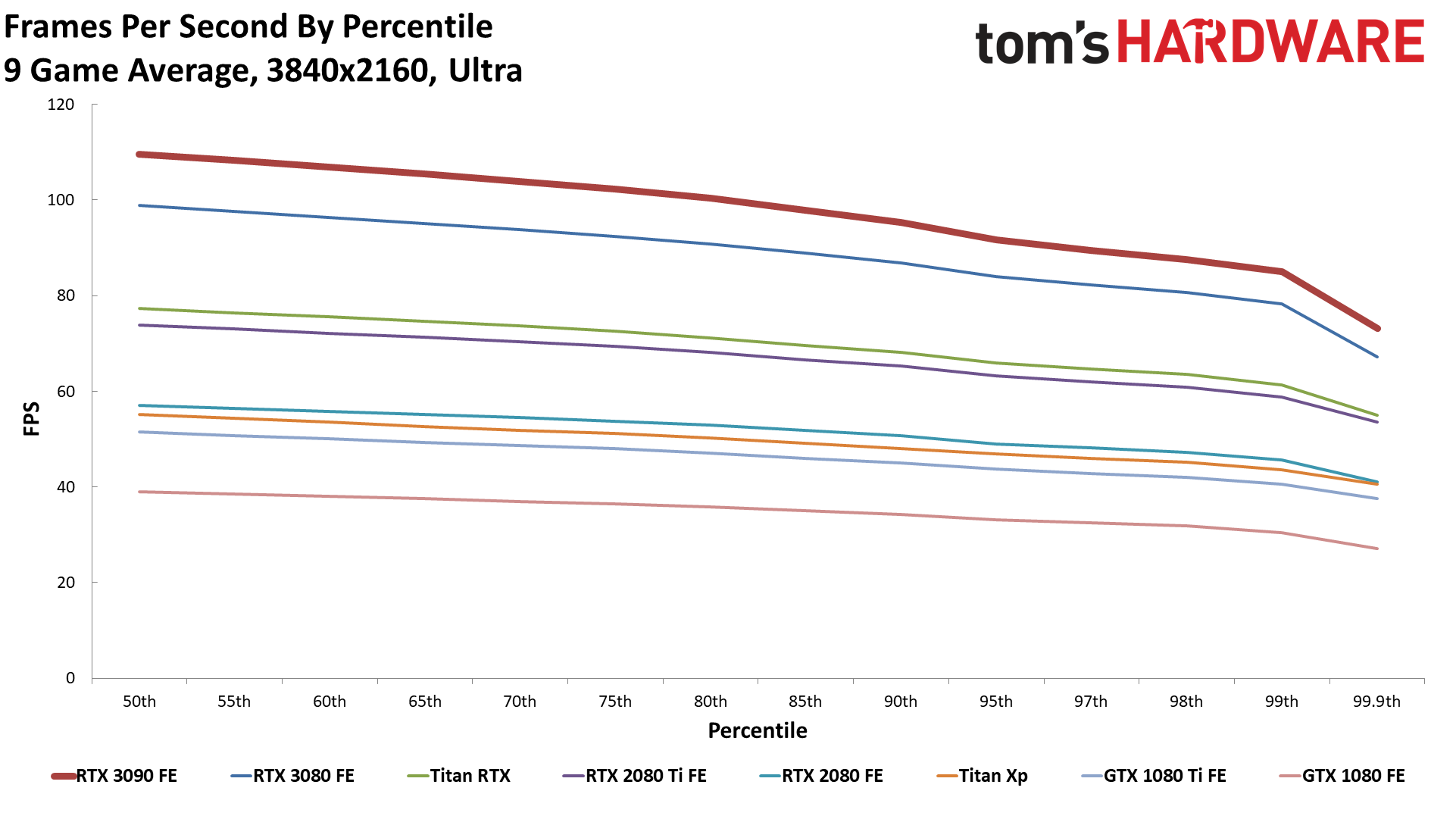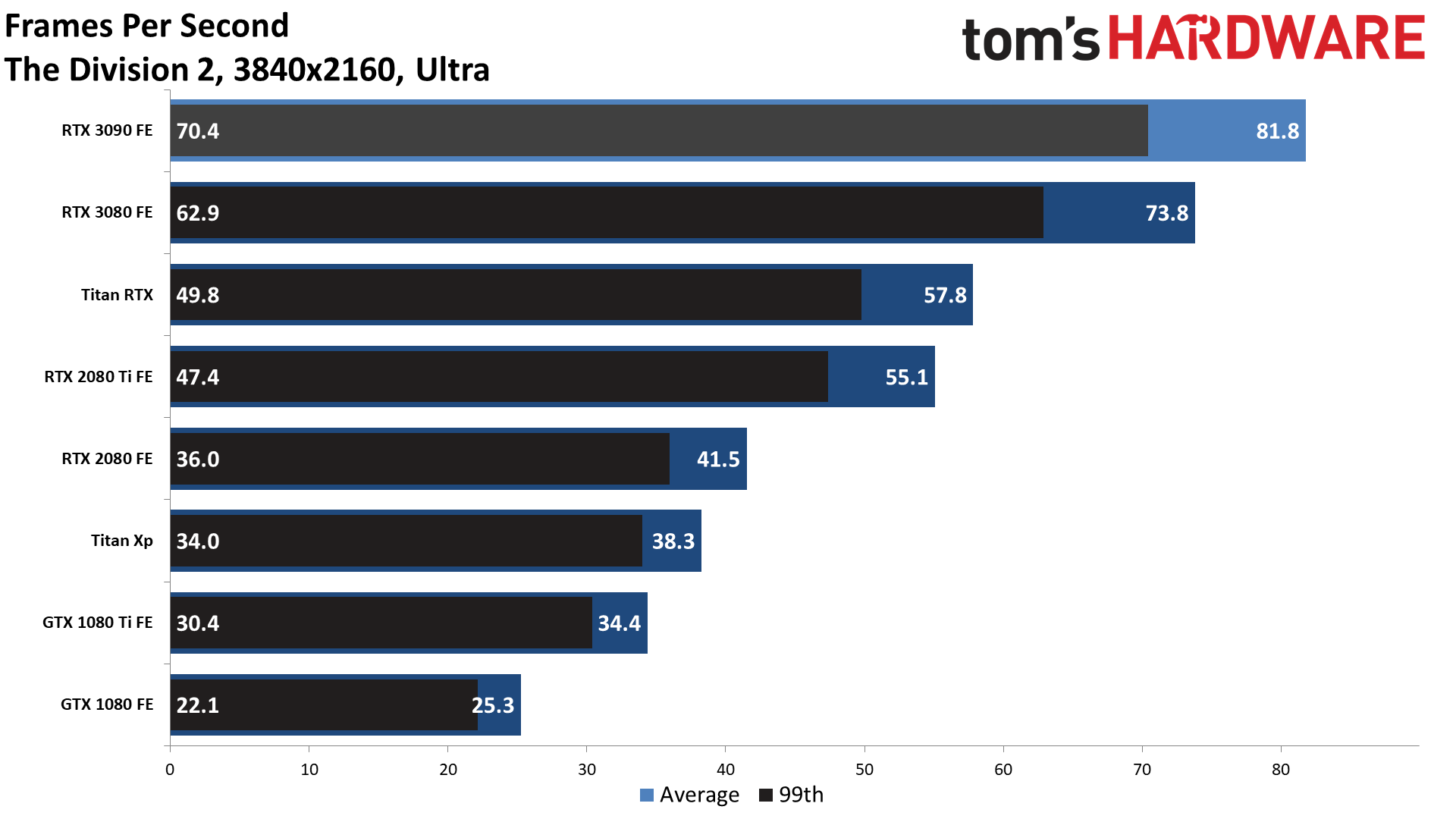Why you can trust Tom's Hardware
While we've run our full test suite on the RTX 3090 FE, it's very much a card that needs a higher resolution display to reach its potential. At 1080p, without ray tracing effects, the 3090 is only a few percent faster than the RTX 3080. Even at 1440p, the gains are usually less than 10%. Which isn't to say that the 3090 suddenly rockets ahead at 4K ultra, as it's still only 10-15% faster than a 3080 by Nvidia's own admission. But now we can confirm Nvidia's results.
Let's start with the existing (older / lighter) games before moving into the bonus round. For these games, we're limiting our charts to the 4K ultra and 1440p ultra results. What about 5K or 8K gaming? We're looking at ways to test that, but presently lack the necessary display (and time) to make it work. Again, stay tuned for additional coverage.




Right from the start, this is clearly a case of diminishing returns as far as gaming is concerned. Across our older test suite of nine games, even running at 4K ultra, the GeForce RTX 3090 FE is only 10.5% faster than the GeForce RTX 3080 FE. Drop to 1440p ultra, and the performance advantage shrinks to a mere 8%. Part of the problem is the GPUs are so fast that they're hitting CPU limitations, even at 4K ultra. The other difficulty is that at least several of the games are a bit older and lighter.
We'll see in the bonus games that cranking up graphics settings — in particular with games that support ray tracing effects — increases the gap. However, even at 4K with DLSS, the 3090 FE doesn't create a gap that would fully justify its price premium. That's generally been the case with Nvidia's top GPUs, going back to the first Titan cards and the GTX 700-series, though. So let's look at history.
The RTX 3090 is 'only' 10.5% faster than the RTX 3080, at slightly more than double the price. That's rough, but the old Titan cards were worse. Titan RTX was only 4.5% faster than the RTX 2080 Ti, at more than double the price, and cost $1,000 more than the RTX 3090. The Titan Xp did a bit better, with 6.9% higher 4K ultra performance than the 1080 Ti, and it 'only' cost 71% more.
But that's the catch. The Titan Xp was the same price as the 2080 Ti; the RTX 3090 isn't a Titan, and it still costs $1,500. If we look at the 2080 Ti compared to the 2080 FE, it was 29% faster for 70% more money. Meanwhile, the 1080 Ti was 32% faster than the 1080 and took over the 1080 Founders Edition price point. Or one step further back, the 980 Ti was 33% faster than the GTX 980, for $100 more (but came nine months after the 980 launch).
Historically, then, the RTX 3090 is one of the worst values ever for a GeForce card … and it's one of the better values for a Titan-class card. It's still a massive price premium, and it's not even that beneficial for gaming — twice the price for 10-15% more performance. That's a bigger jump in performance than any previous Titan card has offered, though. We'll dig into performance in professional applications once we're through with the games.
Get Tom's Hardware's best news and in-depth reviews, straight to your inbox.




Borderlands 3 is one of the more demanding games, and the GeForce RTX 3090 gets a correspondingly higher benefit compared to the 3080. At 4K ultra it's 14.5% faster than the 3080. It's also 14.6% faster than the 3080 at 4K medium, and at 1440p ultra, it's still 12.5% faster than a 3080. Compared to the Titan RTX, which it sort of replaces at a lower price, the 3090 delivers 55% more performance. It's also just over 60% faster than the RTX 2080 Ti. Overall, Borderlands 3 is the best showing for the 3090 in our current test suite, even though it's an AMD-promoted game.




The Division 2 is another AMD-promoted game, but this time the 3090's performance is basically right in line with the overall average. It's 11% faster than a 3080, but only at 4K ultra — 1440p ultra or 4K medium drops to single-digit percentage point improvements. If you're coming from an RTX 2080 Ti, the RTX 3090 is nearly 50% faster at 4K ultra, and around 40-45% faster at 1440p ultra and 4K medium. It's also 41% faster than the Titan RTX at 4K ultra, and a 30-40% improvement at lower resolutions and settings (besides 1080p medium).




Far Cry 5 is one of the lighter games in our test suite, and also one of the older games — Far Cry 6 is coming next February, and Far Cry New Dawn came out in early 2019 (but with similar performance to its predecessor). The GeForce RTX 3090 still gets 11% higher performance than the 3080 at 4K ultra, but that's a pretty tough sell, and the lead drops to just 3-4% at 1440p and 1080p, if you're wondering.




Final Fantasy XIV is also ready for retirement from our suite, though it continues to scale pretty well with GPU performance. The RTX 3080 FE breaks 120 fps at 4K ultra, which is a first, and it's nearly 15% faster than the 3080. Then again, even a GTX 1080 Ti has been pulling more than 60 fps in FFXIV since 2017.




Forza Horizon 4 wins the prize for the least demanding game in our test suite, as far as relative performance goes. The RTX 3090 is only 9% faster than the 3080, so unless you have an 8K display or maybe a 5K display, such a GPU is overkill. It's also capable of pulling over 144 fps at 4K ultra, which means anyone with a fancy 4K 144Hz HDR G-Sync Ultimate display could actually put it to good use.




We tested Metro Exodus without ray-tracing or DLSS here, though we'll revisit it below with RTX and DLSS enabled. Given the RTX support, it's no surprise this is an Nvidia-promoted game. The RTX 3090 FE ends up delivering 14% higher performance than the 3080, again one of the better showings for the new Not-Quite-A-Titan.




Red Dead Redemption 2 proved to be one of the better games for GPU performance scaling with the 3080 FE, but apparently we've hit the limit with the 3090 FE. It's only 8-10% faster, depending on the resolution and settings you run. It's also the only Vulkan game where performance didn't end up significantly higher than most of the DX12 games — ray traced or otherwise. We're not quite at maxed-out settings (there are about 27 settings you can tweak, and it all has to be done basically manually for consistency), but whatever. At 4K, you can now comfortably clear 60 fps on the 3090, and performance is 40-45% higher than the previous-gen Titan RTX and RTX 2080 Ti.




Shadow of the Tomb Raider is another RTX-enhanced game that we'll revisit below in our bonus round. Running in traditional rasterization mode at 4K, the 3090 ends up 13% faster than the 3080, so it's another decent showing. Drop below 4K, however, and you're looking at a negligible 6% or less benefit. That's better than SLI in some games, which is now basically dead. RIP, SLI — though Shadow of the Tomb Raider is one of the few games that actually supports it, so, you know: dual RTX 3090s for $3000!




Last is Strange Brigade, a game that uses the Vulkan API and also tends to hit very high framerates. For example, the RTX 2080 Ti already manages 114 fps at 4K ultra, but the 3090 jumps to 181 fps — nearly 60% faster and another use case for 4K 144Hz displays. It's also the biggest lead for the 3090 over the 3080 so far, at 16%. You still get good scaling even at lower settings, as well — over 300 fps at 1440p ultra, and 380 fps at 1080p ultra. Too bad the game isn't a popular esports title.
Current page: GeForce RTX 3090: Built for 4K and Beyond
Prev Page GeForce RTX 3090 Founders Edition: Design, Cooling, Aesthetics Next Page GeForce RTX 3090: Bonus Round 4K Ultra, Ray Tracing, and DLSS Gaming
Jarred Walton is a senior editor at Tom's Hardware focusing on everything GPU. He has been working as a tech journalist since 2004, writing for AnandTech, Maximum PC, and PC Gamer. From the first S3 Virge '3D decelerators' to today's GPUs, Jarred keeps up with all the latest graphics trends and is the one to ask about game performance.
-
VforV "Titan-class card" - again with this nvidia BS?Reply
It's not, it's a catchphrase from nvidia and the media keeps playing this tune. It's only a more expensive 3080 Ti, which will be proven soon. A halo product for people with more money than sense.
"Fastest current graphics card, period" - Wrong, it's not, it's based on the game and if it's optimized for nvidia (DLSS) or AMD (and no DLSS). In the first case it wins in the latter one it gets beaten by RX 6800 XT and RX 6900 XT, sometimes by a mile... as much as it beats them in the first case with DLSS ON, but then AMD does it by raw power. So it's 50/50, period.
"8K DLSS potential" - yeah, sure "potential". If you count dreaming of 8k gaming potential too, then yes. Again nvidia BS propagated by media still.
"Needs a 4K display, maybe even 8K" - no it does not "need" an 8k display unless you want to be majorly disappointed and play at 30 fps only. That is today, with today games and today's graphics demands, but tomorrow and next gen games you can kiss it goodbye at 8k. Another nvidia BS, again supported by the media.
GJ @ author, nvidia is pleased by your article. -
Loadedaxe Titan Class card? No offense, but to Nvidia it is. The rest of the world its a 3080Ti.Reply -
HideOut Mmmm 2 months late for a review? Whats happened to this company. Late or missing reviews. Nothing but rasberry Pi stuff, and sister publication anantech is nearly dead.Reply -
Blacksad999 Reply
Yeah, the Raspberry Pi stuff is getting annoying. They brought out their 5800x review way after the fact, too. Kind of odd. I understand it's a difficult year to review things, but months later than most review sites isn't a good look when that's supposed to be the sites specialty.HideOut said:Mmmm 2 months late for a review? Whats happened to this company. Late or missing reviews. Nothing but rasberry Pi stuff, and sister publication anantech is nearly dead.
